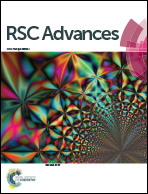Nano Ru catalysts supported on carbon nanotubes for cellobiose conversion to sugar alcohols: effects of CNT channel size
Abstract
Ruthenium (Ru) nanoparticles (NPs) were supported on the interior surface of carbon nanotubes (CNTs) with different inner diameters to study the effects of CNT channel size on the cellobiose conversion. It was found that the reducibility and catalytic activity of Ru/CNT-in sample was enhanced with the decrease of the carbon channel size and Ru/CNTs-in catalysts showed significantly higher catalytic activities than that of the Ru/CNTs-out sample. The confinement effect of the CNT channel was gradually enhanced with the decrease of the nanotube channel size (inner diameter). The encapsulation of Ru NPs inside the CNT channels improved the Ru reducibility and decreased the leaching of catalytic sites.


 Please wait while we load your content...
Please wait while we load your content...